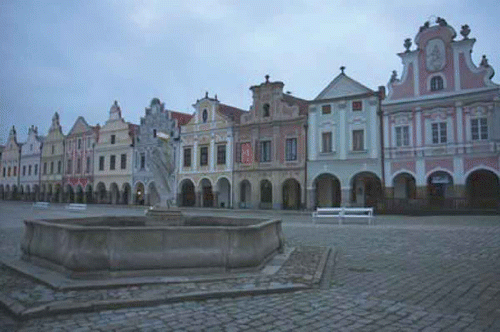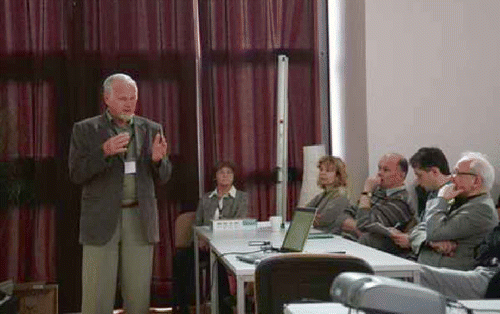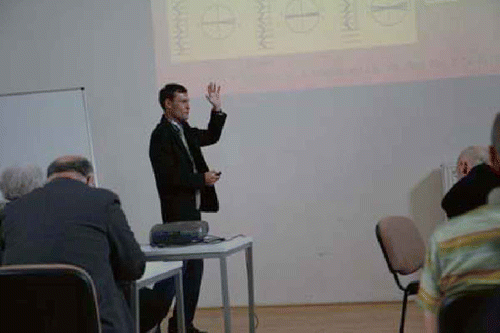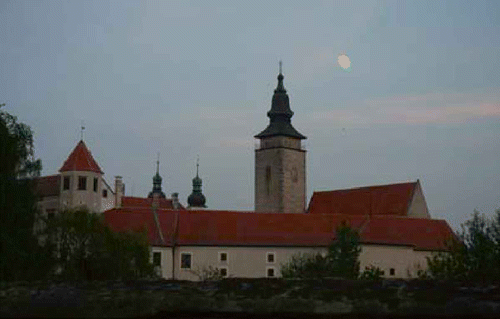Structural and ferroelectric phase transitions, Telč, Czech Republic, 24–28 May 2010
From 24–28 May, the XIX Czech–Polish Seminar ‘Structural and ferroelectric phase transitions’ was held at the picturesque old town of Telč, located among the beautiful hills of the Moravia region (Czech Republic) ().
Every second year over the past 30 years the seminar gathers Czech and Polish scientists at a stimulating and interdisciplinary forum for the presentation of the best and newest results. Year by year this periodical meeting has developed into the form of an international symposium, gathering participants from all over the world for common discussion of contemporary problems of physical research of condensed matter.
The seminar was perfectly and pleasantly organised by collaborating scientists from the Institute of Physics of the Academy of Sciences of the Czech Republic from Prague (Czech Republic) and the Institute of Molecular Physics of Polish Academy of Sciences from Poznań (Poland).
The scope of this meeting was focused on very recent achievements in the field of ferroelectric materials – solid and liquid crystalline ones. The local organising committee (A. Bubnov, J. Hlinka, S. Kamba, V. Novotna, J. Petzelt and J. Pokorny) perfectly chose the conference venue (hotel Anton), which was located in the vicinity of the old town market and a beautiful park. This year, the four-day meeting gathered at Telč over 125 participants to share their experiences and accomplishments with fellow colleagues and experts (). The participants, in almost equal proportions, came from the Czech Republic, Poland and from another 15 countries (on four continents).
Figure 2. Participants of the XIX Czech--Polish seminar on structural and ferroelectric phase transitions (photo courtesy of Dr A. Bubnov).

The program consisted of 40 lectures presented during eight sessions and 83 poster presentations, which were displayed during the entire meeting and discussed during two poster sessions. The seminar was opened by Professor J. Hlinka from the Institute of Physics, Academy of Sciences of the Czech Republic, who recalled and briefly summarised the over 30-year tradition of meetings alternately organised in the Czech Republic (and former Czechoslovakia) and Poland. The obituary to Professor Jan Stankowski was subsequently given by Professor Krystian Roleder. The scientific program was opened by a review lecture by Professor W. Kleemann, who presented the current state of the art of investigations of magnetoelectric effects, which have vitally been boosted by recent research on multiferroic materials. This also opened the series of presentations devoted to solid crystalline oxides exhibiting very interesting properties, including multiferroic ones.
The liquid crystalline branch of the meeting was opened by Professor S. Urban (Jagiellonian University, Kraków, Poland) with his interesting lecture, which reported an extensive study of mesogenic behaviour and the evolution of physical properties of homostructural biphenylene compounds under high pressure (see ). The unexpected induction of the nematic phase was discussed in the context of the molecular properties of the examined compounds.
Dr A.V. Emelyanenko (Moscow State University, Russia) devoted his interesting lecture to the molecular-statistical approach of the evolution of the anticlinic smectic C (SmCA*) phase, intermediate phases and synclinic smectic C (SmC*) phase under an applied electric field (). He pointed out the importance of the induced polarisation of the medium, usually omitted, and its influence on the dynamics of the medium under an electric field. The afterward discussion concerned the nature of the induction of the syn- and anticlinic smectic phases.
Very clear and inspiring observations of specific properties of oriented molecules and their evolution upon phase changes made by means of nuclear magnetic resonance (NMR) were presented by Dr V. Domenici (Pisa University, Italy). The deuterated materials were studied to access the molecular average conformation within the SmC* phase. These results shone a bright light on molecular reorientation dynamic properties during phase changes.
A very interesting contribution was delivered by Dr V. Novotna (Institute of Physics of the Czech Academy of Sciences, Prague). She presented out of the ordinary observations of the re-entrant low-oriented synclinic smectic A (SmA*) phase below the ferroelectric SmC* one. This unique effect was observed for compounds having a molecular core comprising two biphenylene units connected by an ester group. The re-entrant SmA* phase exhibits a strong electroclinic effect at a relatively low temperature and a broad temperature range, which is inspiring from an application point of view. The presented observations were discussed on the basis of the electro-optical studies, the dielectric spectroscopy and X-ray scattering results. The theory based on Landau potential has been developed and discussed.
The new impact to the everyday experimental technique, which is the study of dielectric properties of polar materials, was given by Dr P. Perkowski (Military University of Technology, Warsaw, Poland). He proposed a modified equivalent scheme of the measuring cell. On the basis of the detailed calculations, the effect of the screening of the high-frequency modes by the cell mode occurring due to the finite conductivity of electrodes was presented. The method of extracting physical behaviour from experimental results obtained by using typical cells was presented and proved with careful experimental and theoretical studies.
Within the poster sessions, recently obtained new kinds of liquid crystalline materials were presented. Among them new approaches to the induction of the de Vries-like phases by incorporating the organosiloxane dopant were presented by A. Borger (University of Stuttgart, Germany). A few other compounds with de Vries-like properties were presented by different groups manifesting a current interest in developing effective potentially applicable smectic materials. Photo-switchable liquid crystalline compounds exhibiting ferro and antiferroelectric phases were presented by M. Glogarova et al. (Institute of Physics, Prague). The same group also presented a homologue series of polar mesogens with the keto group. Their extensive investigation was done for assessment of the influence of the molecular elements on mesogenic behaviour and physical properties of ferro and antiferroelectric phases. Physical and optical properties of new, long-pitch orthoconic antiferroelectric mixtures for applications were demonstrated by the Warsaw group (Military University of Technology (MUT), Warsaw, Poland). New mesogenic bend core materials (K. Fodor-Csorba, Hungary), twist-grain-boundary (TGB) phases undergoing phase transitions to various modifications of this structure (A. Khandelwal, India) and composites with nanoparticles (E.A. Soto-Bustamante, Chile; B. Rozič, Slovenia) were shown. The long discussion during the poster sessions was very profitable.
Besides its high scientific level, the Czech–Polish periodical meetings are known for their stimulating atmosphere and informal discussions, as well as exchange of knowledge and ideas. All of these features were also present at this time. The seminar location in Telč (see and ), which is known as one of the most appealing towns of the Czech Republic and also recognised by UNESCO, was perfect for scientific activities and leisure. Cultural and social events (including common singing of songs with intentionally prepared songbook) and the hospitality of organisers during the meeting were exemplary.
I would like to express congratulations to the organising team for the perfection of the meeting organisation and the atmosphere, which they created. All participants welcome the announcement of the continuation of the meeting in two years in Poland.
Wiktor Piecek
MUT, Poland



